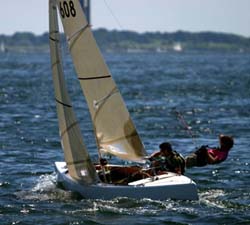Cape Cod Frosty
 For most sailors, the blustery onset of fall weather signals post-season sailing withdrawal, haul-out, and a generally gloomy winter outlook. For a growing group of hardy souls, however, this time of year brings new excitement. At six feet overall length and 36 pounds minimum weight, the Cape Cod Frosty is the world’s smallest IYRU sanctioned one design class.Sailed in late fall, winter and early spring, this class
For most sailors, the blustery onset of fall weather signals post-season sailing withdrawal, haul-out, and a generally gloomy winter outlook. For a growing group of hardy souls, however, this time of year brings new excitement. At six feet overall length and 36 pounds minimum weight, the Cape Cod Frosty is the world’s smallest IYRU sanctioned one design class.Sailed in late fall, winter and early spring, this class
is gaining popularity among sailors of all ages and abilities, who are ultimately united by one common desire – to extend the sailing season.
In December 1984, Tom Leach, harbour master at Harwich, Massachusetts, designed a boat small enough to be carried through a doorway, suitable for car top (or back seat) transport, and with sufficient stability to be safe in cold waters. This was the birth of the single handed Cape Cod Frosty, a boat intended for use in protected water such as sheltered bays and harbours. Initially, Tom’s creation was received by the local sailing community with laughter but after his friends witnessed the little wonder, blasting about the waters of Wychmere harbor, they all wanted one too.
By January 1987, the fleet membership totaled 275, with a class association, rules, a newsletter and an active Sunday afternoon racing schedule. This was just the beginning. Today there are over one thousand boats in 10 fleets in various eastern states, in addition to two healthy Canadian fleets – The Shark’s Bay Frosty Fleet (Toronto Sailing and Canoe Club), and The Far North Frosty Association (Montreal’s Pointe Claire Yacht Club). Most fleets host Sunday afternoon racing, and with a friendly rivalry brewing between the Montreal and Toronto fleets, there are two main annual regattas. Frostyfest is held in mid to late October at P.C.Y.C., and the Sharks Bay fleet runs an annual charitable event at T.S.&C.C., the Ice Bucket Benefit regatta. Proceeds are donated to the Children’s Wish Foundation. The Canadian Championship regatta alternates between these two venues, and will continue to do so until another interested fleet pops up.
A tight one design class, builder/racers pride themselves on competing in boats that are ‘equally slow’. Tacks are used cautiously, and it is advisable to foot as much as possible. A common racing instructions amendment eases the severity of rule infractions to a 360 degree turn, as a 720 degree penalty is certain to put a competitor hopelessly behind. All-up weight is strictly enforced to a minimum of 214 pounds. At regattas this is accomplished with a bathroom scale. Competitors weigh themselves while holding their craft.
Racing is most often carried out on small Olympic triangle courses set inside harbor confines. The small race area and consistent boat speed makes for exciting, close racing, and much more frequent passing than in other classes.
The simple design uses inexpensive materials, keeping the overall, fully-rigged cost to less than $400. Often, batches of 10 or more boats are constructed in a co-operative effort, which drives the costs even lower. This is a fun winter activity for sailing club members, and generates savings associated with the bulk purchase of materials such as epoxy, wood and spars. Group building is also faster than building alone, as the process can be organized into an assembly-line whereby several stations are set up, each responsible for one stage of construction. Cutting panels from templates available from the class association achieve accurate adherence to class rules. The rules also prevent competitive builder/racers from getting carried away with exotic enhancements. For example, the foils must be made of wood only – reinforcement with fiberglass cloth and jybing dagger boards are not allowed. While fiberglass kits are available in varying degrees of assembly, the wooden version is extremely easy to build using the stitch and glue method. The hull panels are normally jig-sawed from 1/4 in. water-proof sub-floor plywood and the spars are made from standard electrician’s conduit (available at electrical supply stores).
Most Frosty owners express themselves with flashy hull paint jobs, vividly colored sails, and clever boat names that play on themes of ice, low temperature and being cool.
To see if this boat is available, go to http://www.boatcan.com for listings!























